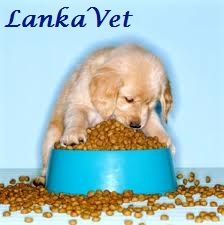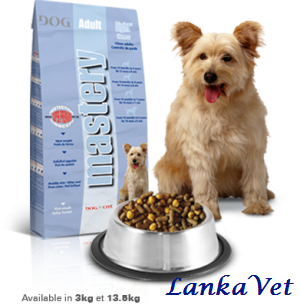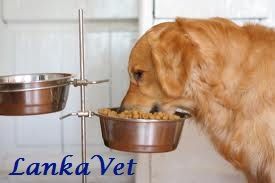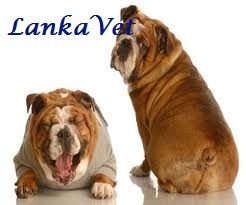These feeding directions are based on using an 8 oz. measuring cup. It is recommended to divide the daily ration into two or more separate feedings
rather than just one big meal at a time. Puppies should be fed more often than
adult dogs. When adding in canned food cut the dry by up to half the amount and
substitute the same volume that you cut with canned food, so the dog is getting
the same amount of food, some dry and some wet. Note, if you are feeding a good
quality dog food you will be able to feed less as the dog's body will utilize
more and poop out less. It is best to consult your vet about the specific needs of your
pet.
The first 8 weeks
 Puppies should not be separated from their mother before they are 8 weeks
old. Puppies that leave their mothers sooner have a rougher time adjusting and
a higher incidence of illnesses. It may be due to weakened
immunity or mourning the early loss of their family. Their mother's milk
provides them with the nutrition and immunity which needed to become healthy
dogs. At three to four weeks of age, puppies should begin eating some solid food. You
can try mixing three parts food with one part water or puppy replacement milk.
This will make the food easier to digest. If your puppy begins
eating a little solid food before it leave its mother it will have an easier
time adjusting when you bring it home.
Puppies should not be separated from their mother before they are 8 weeks
old. Puppies that leave their mothers sooner have a rougher time adjusting and
a higher incidence of illnesses. It may be due to weakened
immunity or mourning the early loss of their family. Their mother's milk
provides them with the nutrition and immunity which needed to become healthy
dogs. At three to four weeks of age, puppies should begin eating some solid food. You
can try mixing three parts food with one part water or puppy replacement milk.
This will make the food easier to digest. If your puppy begins
eating a little solid food before it leave its mother it will have an easier
time adjusting when you bring it home.
6 - 8 weeks
Feed your puppy 3-4 times a day. Puppies have different nutritional needs
than adult dogs. Choose a puppy food that provides the appropriate balance of
nutrients your puppy needs. Be sure it is getting the right amount of protein
and calcium, and the proper amount of calories. Check the label to determine if
you are feeding your puppy a balanced diet.
Feed your puppy twice a day.
3 - 6 months
Your puppy will be teething. He may become a finicky eater or lose his
appetite. Keep feeding him nutritious food twice a day. If he has an upset
stomach for more than one or two days, take him to the veterinarian.
6 months to 1 year
Your puppy may look all grown up but he is still a puppy. He should still
be fed a high quality food for the added nutrition. If
you are feeding a puppy food ask your veterinarian when you should switch to
adult food. Make sure the adult food you switch to is still a balanced high
quality diet with the first ingredient being a specified meat that is not a
by-product.
Feeding should be twice a day.
1 year
In most breeds feeding should be twice a day.
Breed
|
Weight
as an Adult Dog
|
Dry Food
|
Chihuahua,
Yorkshire Terrier, Toy Poodle
|
Up to 10
pounds
|
1/4 to ¾
cups
|
Miniature Poodle,
Scottish Terrier
|
10-25 pounds
|
3/4 to 1 cups
|
Cocker
Spaniel, Beagle,
Springer
Spaniel
|
25-50
pounds
|
1-2 cups
|
Collie, Boxer, Labrador,
Golden Retriever
|
25-50 pounds
|
2-2 ½ cups
|
Great
Dane, Malamute,
St.
Bernard, Mastiff
|
Over 75 pounds
|
2-4 cups
|
Good Basic Dogs Feeding Tips
- Feed at the same time every day, it would keep your dog on a bathroom schedule.
- Ask your vet how many times a day, you should feed your dog.
- Feed your dog the same type and brand of food every day. Unlike humans, a dog's digestive system cannot handle changes in food. It can cause upset stomach and diarrhea.
- When switching to a new food gradually transition him to the new food by mixing portions of both foods until you slowly phase out the old food. Your dog may experience diarrhea if his food is suddenly changed.
- If you are mixing water into dry food you should mix 4 parts dry food to 1 part water.
- Keep fresh drinking water available at all times. Change the water at least once a day.
- Keep food and water bowls clean.
- Don’t over feed your dog.
- Follow the guidelines on the dog food package for recommended feeding amounts.
- Monitor your dog's weight and activity level, and make feeding adjustments as necessary.
- If your dog has loose stool feeding sweet potatoes is a natural stool hardener. Unlike some medicines, giving too many will not make them constipated. You can buy sweet potato chips for dogs in a pet supply stores.




No comments:
Post a Comment